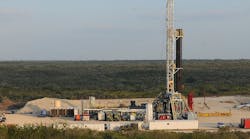H.U. Khan, S.Y.K. Dilawar, S.P. Nautiyal, S.P. Srivastava
Indian Institute of Petroleum
Dehradun, India
A new, alternative method determines petroleum fluid pour points with 1 C. precision and better accuracy than the standard ASTM D-97 procedure.
The new method measures the pour point of transparent fluids by determining wax appearance temperature (WAT). Also, pour points of waxy crude oils can be determined by measuring a flow characteristic called "restart" pressure.
POUR POINT
Pour point is the temperature at which the flow of crude oil, or other petroleum fluids, ceases. It is an important indicator of the transition of flow from Newtonian to non-Newtonian characteristics.' Pour point provides, to a good approximation, information about this transition temperature.
ASTM method D-97 has, to date, been the easiest and quickest method of determining the pour point of waxy petroleum fluids.' Many researchers have attempted to increase the precision and accuracy of pour point measurements.2 All such approaches, however, have not been able to produce better repeatability (precision) than 3 C. or reproducibility (accuracy) better than 6 C.
The Indian Institute of Petroleum undertook a study to determine the pour point of transparent fluids through measurements of WAT and, for doped or undoped waxy crudes, through measurements of restart pressure using a 6-mm model pipeline . 4
Table 1 gives the characteristics of the three Indian crude oils used in the study:
- Bombay High (BH) crude oil
- Ratna crude oil
- Borholla crude oil.
WAT
Homogeneous paraffin wax solutions were prepared in 14 solvents. In each solvent, paraffin solutions were prepared in concentrations of 2.5 wt %, 3 wt %, 10 wt %, and 20 wt %. Pour points were determined using ASTM D-97.
All the samples were preheated to 60-75 C., then statically cooled at a rate of 0.15 C./min. The temperature at which turbidity first occurred was recorded as the wax appearance temperature.
Table 2 shows the results of these tests.
RESULTS
The data in Table 2 show that, for all solvents, the measured wax appearance temperatures are within 2 C. of their respective pour point temperatures for 5, 10, and 20 wt I,", solutions. But for 2.5 wt % solutions, although more than 99% of the solution congealed at or near the WAT, in some cases a very small portion of the solution continued to flow, even at the WAT/pour point temperatures.
In those cases, the lowest temperatures at which flow was observed are shown in parentheses. These results indicate that 5 wt % is the minimum concentration that can form a gel that "holds" all of the solvent on chilling.
Further, the test results indicate that for transparent wax fluids with wax concentrations of 5-20 wt % the WAT measurements produce a close approximation of pour point temperature.
This new method of pour point determination via WAT measurement is a logical extension of a different ASTM procedure, D-3117, which correlates the cloud points of petroleum fluids containing less than 5-4% wax with their wax appearance temperatures. 5
Thus, for appropriate concentrations of wax in petroleum fluids, WAT can be used to determine the pour point and cloud point of those solutions.
An advantage of this method over ASTM D-97 is that the new technique is based on observing turbidity rather than flow. Turbidity can be measured easily to an accuracy of 0.5 C. In addition, the reproducibility of the results 1 C. for the new method-is far better than that of the ASTM method. The new method is not applicable, however, to dark-colored liquids.
POUR/FLOW TEMPERATURES
The Indian Institute of Petroleum undertook a related study to correlate the pour points of crude oils (dark petroleum fluids) with a flow characteristic called "restart pressure."
Homogeneous samples of crude oil-each about 600 g-were charged to a dewaxing flask connected to a 6 mm model pipeline. The sample temperature was maintained at 50 C. and the flask was rotated at 80 rpm for 30 min. The charge was then cooled to 36.5 C. at a rate of 0.15 C./min.
After about 15 min at 36.5 C., the crude oil was pumped to the pipeline by applying nitrogen pressure (14.5 cm mercury). The crude was then statically cooled at 0.15 C./min, until it reached its previously determined pour point.
The sample was maintained at that temperature for 1 hr. The charge was then displaced by an incoming fluid (kerosine) of approximately the same density as the crude oil. The kerosine was pumped in by applying nitrogen pressure (I .5 cm mercury).
If the gelled crude oil flowed (defined as 2 ml flow in 15 min) at that nitrogen pressure, the crude was further cooled at the same rate. And with every 1 C. decrease in temperature, the flow wag measured again by the method described (i.e., 1-hr holdup time).
The temperature at which the nitrogen pressure of 14.5 cm mercury produced the required flow (2 ml in 15 min) was defined as the flow temperature of the crude oil sample.
On the other hand, if at the initial pour point the nitrogen pressure required to produce the necessary flow of oil was greater than 14.5 cm mercury, the temperature of the crude oil was increased in 1 C. increments. Following this procedure, the flow of the oil was noted at every 1 C., until the desired conditions of pressure and flow were obtained.
These measurements were also performed on some of the paraffin wax solutions. The results of these tests are summarized in Table 3.
RESULTS
The comparison of the pour points of the three waxy crudes (dark liquids) and six of the paraffin solutions with the flow temperatures obtained on the model pipeline indicated good correlation of the two data sets. It should be noted that the pour points are generally less than the measured flow temperatures.
This difference between the two measurements is a maximum of 3 C., which is well within the permissible limits of ASTM D-97, and hence, acceptable.
Further, the observations taken on the model pipeline are within the repeatability limit of 1 C. This method is therefore advantageous over ASTM D-97, which has a repeatability of about 3 C.
The only requirement for the new method is prior knowledge of the approximate pour point of that fluids. Otherwise, the experimental time required for the trial-and-error procedure might slightly increase.
It should also be noted that this method more easily predicts petroleum fluid qualities, particularly their low-temperature flow characteristics. The method is also helpful in assessing the performance of flow-improver additives in various solvents.
ACKNOWLEDGMENT
The authors wish to thank their colleagues Mohammad Anwar and Dr. D. C. Madhwal, and Dr. T.S.R. Prasad Rao, director of the Indian Institute of Petroleum.
REFERENCES
- ASTM standards, Petroleum Products and Lubricants, American Society for Testing & Materials, U.S., 1983, Section 5, p. 30.
- Wardhaugh, L.T. and Boger, D.Y., Chem. Eng. Res. Dev., Vol. 65, 1987, p. 74.
- Srivastava, S.P., Agrawal, K.M., Verma, P.S., joshi, G.C. and Tandon, R.S., VII LAWPSP symposium, department of chemical engineering, Indian Institute of Technology, Bombay, Jan. 19-21, 1991.
- Khan, H.U., Agrawal, K.M., Surianarayannan, M., and Joshi, C.C., Oil Gas European Magazine, January 1990, pp. 41-43.
- Annual book of ASTM standards, Petroleum Products and Lubricants, American Society for Testing & Materials, U.S., Mar. 23, p. 38.
Copyright 1993 Oil & Gas Journal. All Rights Reserved.

